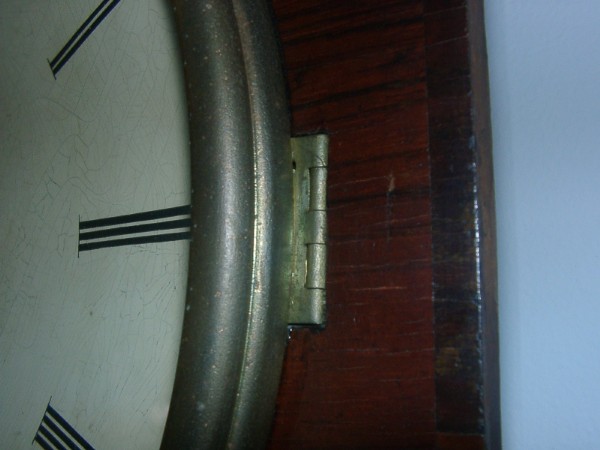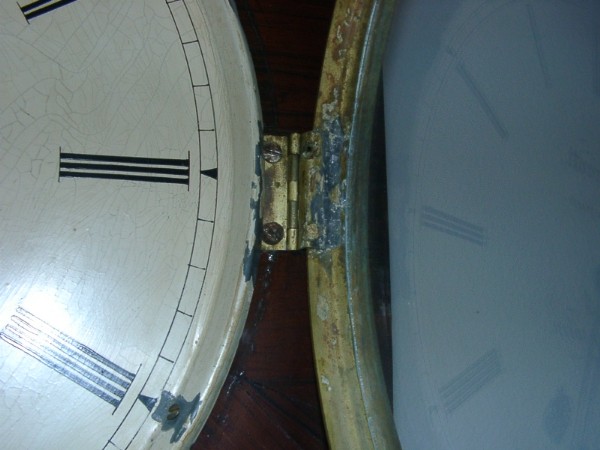
| WWT Shows | CLICK TO: Join and Support Internet Horology Club 185™ | IHC185™ Forums |

|
• Check Out Our... • • TWO Book Offer! • |
Welcome Aboard IHC185™  Internet Horology Club 185
Internet Horology Club 185  IHC185™ Discussion Site Main Page
IHC185™ Discussion Site Main Page  Horological Discussions, Questions and Answers
Horological Discussions, Questions and Answers  Clocks, Including 400-Day Discussions
Clocks, Including 400-Day Discussions  Dial replacement
Dial replacement
 Internet Horology Club 185
Internet Horology Club 185  IHC185™ Discussion Site Main Page
IHC185™ Discussion Site Main Page  Horological Discussions, Questions and Answers
Horological Discussions, Questions and Answers  Clocks, Including 400-Day Discussions
Clocks, Including 400-Day Discussions  Dial replacement
Dial replacementGo  | New Topic  | Find-Or-Search  | Notify  | Tools  | Reply to Post  |  |
I have an SLarose paper dial for the Welch calendar regulator. The current dial is a paper replacement which has some bubbles in it. The metal part of the dial is concave and as I imagine gluing a flat piece of paper onto it, I can see why wrinkles and bubbles are there. Is there a secret to gluing these paper dials onto concave dial surfaces, without getting wrinkle and bubbles? Charlie | |||
|
Well, on second look, it is not a concave dial, it is sunk in the middle like a double sunk pocket watch dial (w/o the seconds bit). What kind of glue do you use on the paper dials. Charlie | ||||
|
Charlie, I haven't glued a dial, but I know for paper work, rubber cement does not wrinkle the paper and can be applied to be temporary or permanent. Tom Seymour NAWCC #41293 IHC #104 IHC Exec.V.P. | ||||
|
Wall paper glue make paper very pliable allowing to conform to irregular surfaces easily, probably it can work.. | ||||
|
I am getting the impression that gluing paper dials onto vintage clocks is not something collectors like to hear. Sort of like using reproduction dials on pocket watches. I own 4 clocks, all of which have brass dials in good condition except for the Welch Regulator. Were these dials originally paper? If not, what was used. Is there alternatives to "restoring" other than paper dials? It currently has a poorly installed paper reproduction dial now. Charlie | ||||
|
Original dials were made from many things from painted wood, enamel, painted metal and, of course - paper. For some clocks a paper dial is just the right thing. I think dial replacement for clocks follows the same discussion that one goes through to replace dials for watches. Replace only if the original is not useable or presentable at all. The replacement should be of appropriate material and design to be faithful to the original. Tom Seymour NAWCC #41293 IHC #104 IHC Exec.V.P. | ||||
|
| IHC President Life Member |
Anyone who missed Charlie's great clock be sure look at "Welch Calendar Regulator" in this forum. Congratulations on a great find Charlie! Tom's advice is well-taken on anything old that we are entrusted with. We must remember we are Caretakers of Horological History and today as never before we understand and appreciate how fragile some of the history is. Do your research, formulate a plan and proceed carefully. | |||
|
Thanks Tom and Lindell This clock has been through 2 sets of "restoring" hands that probably knew less than me on restoring clocks. It has a replacement paper dial and from what I see in one book, paper looks to be the original material. The current dial was not cut round. The bezel/glass has been attached by rivets and solder to the dial pan itself. Their are holes in the octagonal surround that look like the hinge was attached to it. I would like to see an original set up for one of these clocks, so I can "restore" it, at least to improve the functionality of the hinge. The bezel swings down an inch or two when it is opened, no doubt due to the current attachment method. I pulled the dial and it is marked E.N. Welch. No serial #, I presumed they were not used on clocks of this vintage. There is one foreign screw, everything else in the movment looks original and it is keeping very good time ( and date). I really like this clock and look forward to getting the bezel straightened out and having it ticking away on my wall. Thanks for all the help. Would appreciate if someone could post a pic of the hinge on a similar regulator clock. Charlie | ||||
|
Charlie, The best I can do is a picture of a Jerome short drop octogan. On the outside the hinge has been set into the surrounding wood. However, when you view the inside, yu will see this is not a factory installation. The screws are mismatched and the solder job on the hinge is not the greatest. The glass and bezel do sag a bit when opened. I don't know of too many that dont. I don't know if these picts will help, but thought I would throw them into the conversation on how to do this correctly. Tom Seymour NAWCC# 41293 IHC# 104 IHC Executive V.P.  | ||||
|
Outside: Notice the hinge is countersunk into the molding. Tom Seymour NAWCC# 41293 IHC# 104 IHC Executive V.P.  | ||||
|
On the inside you can see that this is not how it came from the factory. This is how I recieved it. I don't know how old the repair is. What is the setup on yours like? Tom Seymour NAWCC# 41293 IHC# 104 IHC Executive V.P. [This message was edited by Tom Seymour on October 28, 2003 at 19:20.]  | ||||
|
Thanks for the pics Tom. Mine hinge is similar, but the rear half is soldered to the back of the dial pan !!! It really helps to see pics of these things. Charlie | ||||
|
| Powered by Social Strata |
| Your request is being processed... |
|
©2002-2025 Internet Horology Club 185™ - Lindell V. Riddle President - All Rights Reserved Worldwide

